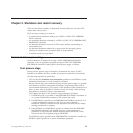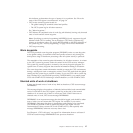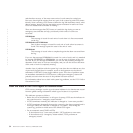
The next initialization of CICS must be an emergency restart, in order to preserve
data integrity. An emergency restart is ensured if the next initialization of CICS
specifies START=AUTO. This is because the recovery manager’s type-of-restart
indicator is set to “emergency-restart-needed” during initialization, and is not reset
in the event of an immediate or uncontrolled shutdown.
Uncontrolled termination
An uncontrolled shutdown of CICS can be caused by a power failure, machine
check, or operating system failure.
In each case, CICS cannot perform any shutdown processing. In particular, CICS
does not write a warm keypoint or a warm-start-possible indicator to the global
catalog.
The next initialization of CICS must be an emergency restart, in order to preserve
data integrity. An emergency restart is ensured if the next initialization of CICS
specifies START=AUTO. This is because the recovery manager’s type-of-restart
indicator is set to “emergency-restart-needed” during initialization, and is not reset
in the event of an immediate or uncontrolled shutdown.
The shutdown assist transaction
On an immediate shutdown, CICS does not allow running tasks to finish. A
backout is not performed until an emergency restart.
This can cause an unacceptable number of units of work to be shunted, with locks
being retained. On the other hand, on a normal shutdown, CICS waits indefinitely
for running transactions to finish, which can delay shutdown to a degree that is
unacceptable. The CICS shutdown assist transaction improves both these forms of
shutdown and, to a large degree, removes the need for an immediate shutdown.
The operation of CESD, for both normal and immediate shutdowns, takes place
over a number of stages. CESD controls these stages by sampling the number of
tasks present in the system, and proceeds to the next stage if the number of
in-flight tasks is not reducing quickly enough.
The stages of a normal shutdown CESD are as follows:
v In the initial stage of assisted shutdown, CESD attempts to complete a normal
shutdown in a reasonable time.
v After a time allowed for transactions to finish normally (that is, after the number
of tasks has not reduced over a period of eight samples), CESD proceeds to issue
a normal purge for each remaining task. The transaction dump data set is closed
in this stage.
v If there are still transactions running after a further eight samples (except when
persistent sessions support is being used), VTAM is force-closed and IRC is
closed immediately.
v Finally, if there are still transactions running, CICS shuts down abnormally,
leaving details of the remaining in-flight transactions on the system log to be
dealt with during an emergency restart.
The operation of CESD is quicker for an immediate shutdown, with the number of
tasks in the system being sampled only four times instead of eight.
30 CICS TS for z/OS 4.1: Recovery and Restart Guide


















